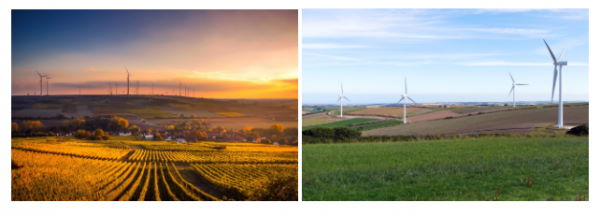Renewable Energy Jobs
Hello again! I’m Dan Frantz, the newest member of the Kurz Wind Team. I’m thankful to be working within the Wind Industry with Kurz Industrial Solutions and wanted to share my experiences throughout the process from initial research to my take on the wind industry itself now that I’ve been here for four months. This is part two of a three-part blog where I’ll be talking about the number of jobs provided in the Wind industry and jobs, so click here for part one and be on the lookout for part three next week!
While many jobs are considered volatile due to emerging markets, the rise of A.I., and technological advancements, there is a huge capacity for job opportunities and advancement within the current business model.
The US has seen an increase of ~97 gigawatts of wind power production increase over the last 18 years. For reference, just one Gigawatt – 1,000 MW – of power is enough to power 700,000 homes, the equivalent of 3.125 million solar panels, and nearly matches the scale of a nuclear power plant which provides 1.21 GW of power.
With the growing output of wind energy and the large-scale impact it has on energy production and household consumption, the number of employment opportunities is nearly matching the MW growth curve.
Career Opportunities
Here is a 4-part, 30,000-foot overview of career opportunities found within wind:
- Raw Materials Manufacturing
- Component Manufacturing
- Project Development
- Operations and Maintenance
Within those broad sectors, here are some of the jobs needed:
- Purchasing and Procurement
- Engineering
- Site Construction
- Administration
- Battery Storage
- Remote Monitoring/IT
- Accounting and Finance
- Wind Turbine Technicians
- Wind Site Managers
- Aftermarket Service and Parts Sales
- Substation Electricians
The list goes on and on with varying levels of skill sets and employment opportunities for the current workforce and outsiders like yourself. If you don’t believe the accelerated growth of wind in the U.S., examine the graph below:
Do I Need A College Degree to be in the Wind Industry?
This is one of the most frequently asked questions for wind job prospects. Our culture drives home the necessity of going to a four-year university, exiting with thousands and thousands of dollars of debt, and we’re left searching for entry-level positions that barely cover a liveable wage. With the growing demand for jobs in wind, there are many positions that do not mandate a four-year degree. In fact, most technician jobs require just a high school diploma and wind technician schooling.
Side Bar – Economics 101: With rising demand in jobs, and a shortage of labor entering the workforce, there is a shortage of qualified and experienced talent. The opportunities for advancement are possible as the industry continues to grow. That’s a win for you!
Some other requirements for wind:
- Mechanical Skills
- Troubleshooting and Problem Solving Skills
- Physical Stamina (hey, someone’s got to climb the tower)
- Data Collection for Analysis
- Wind Technician School
For scholarship opportunities, start HERE for free money.
Now, if you want to design, develop, or drive technological innovation within Wind, you’re probably going to need a four-year degree in engineering, mathematics, or something similar. That said, there are plenty of high-ranking and high-paying wind jobs that do not require formal education.
For more information on how to get into wind technician school, you can check out this link HERE.
We highly recommend you look into applying for multiple scholarships and grants while researching schools in your local area. At Kurz, we’ve even developed two, $1,000 scholarships for people like you to get started with your career in Wind.
In regards to the money, you can start out by making a comfortable living. According to the Bureau of Labor Statistics, the median pay of a wind technician is $53,880 and you can quickly earn up to $76,250 in many cases. If you crush it as a technician, you have the opportunity to elevate within a company to jobs like site manager, where you can make over $100,000 a year without a college degree.
I Already Have the Degree. Now What?
If you’ve already gone through formal education and received a four-year degree in STEM or a similar field, I would still make a strong case that wind can provide the mental, physical, and financial safety net for you to grow your career. Think about this. When looking into a career field, most want the job outline to cover most of the following:
- Financial stability.
- Contribution to a meaningful cause.
- Reasonable hours.
- Benefits like health and retirement.
- Encouraging and engaging company culture.
- Opportunity for advancement.
In Wind, you will have a chance to meet all of the foregoing criteria. Firstly, the average entry-level wind turbine engineer, taking a rough average across different all companies and states, makes around ~$75,000 in their first year. As an engineer advances within a company, the opportunity to earn more will be presented, you can take on more responsibility, and have a yearly salary of around $99,310 (link HERE). Most turbine manufacturers and engineers are centered in a relatively cheap cost of living area making an income that should provide a level of financial prosperity.
To add, Wind energy is making a substantial contribution to cut down on excess pollution and harness the power of nature’s free energy. While the global climate is changing, climate scientists are still debating over the extent of human’s impact on the increase in global temperatures.
Ultimately, we have a responsibility to take care of the Earth and leave it in a thriving and prosperous condition for generations to come. Every day that you walk into work, you can recognize the magnitude of your efforts to increase the amount of energy we can capture from Earth’s most powerful forces.

As for the rest of the upside, it is straightforward. Most Wind employees at the site-level start their day around 7:00 am and leave the premises around 3:30 pm. If you have residual work on which you need to catch up, you can crank out work while overlooking plains and beautiful country with your turbines spinning in the wind. Imagine looking out your office window and looking at this all day:

Typically, you’ll have excellent health, vision, and dental coverage along with a company match to a retirement fund. You and your peers are given chances to bring new ideas to the table and be featured in an employee spotlight for driving innovation. With new concepts, you’ll attain a higher ceiling of financial incentive via promotion and bonuses. At the end of the day, you’re competing with – not against – your peers to refine best practices and find out both large and minute ways to increase company productivity, energy production, or cost savings.
Categorised in: Latest Wind Power Industry News - Kurz Wind Division
This post was written by Aaron Rood


Comments are closed here.